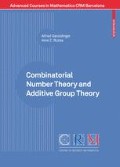Abstract
Let ℕ, ℕ0, ℤ and ℕd denote, respectively, the sets of positive integers, non-negative integers, integers and d-dimensional integral lattice points. Let G denote an arbitrary abelian group and let X denote an arbitrary abelian semigroup, written additively. Let |S| denote the cardinality of the set S. For any sets A and B, we write A∼B if their symmetric difference is finite, that is, if |(A \ B) ∪ (B \ A) | < ∞.
Access this chapter
Tax calculation will be finalised at checkout
Purchases are for personal use only
Preview
Unable to display preview. Download preview PDF.
Bibliography
A. Biró, Divisibility of integer polynomials and tilings of the integers, Acta Arith. 118 (2005), no. 2, 117–127.
B. Bukh, Sums of dilates, arXiv preprint 0711.1610, 2007.
J. W. S. Cassels, Über Basen der natürlichen Zahlenreihe, Abh. Math. Sem. Univ. Hamburg 21 (1975), 247–257.
G. A. Dirac, Note on a problem in additive number theory, J. London Math. Soc. 26 (1951), 312–313.
P. Erdős and M. B. Nathanson, Oscillations of bases for the natural numbers, Proc. Amer. Math. Soc. 53 (1975), no. 2, 253–258.
-, Partitions of the natural numbers into infinitely oscillating bases and non-bases, Comment. Math. Helv. 51 (1976), no. 2, 171–182.
-, Systems of distinct representatives and minimal bases in additive number theory, Number Theory, Carbondale 1979 (Proc. Southern Illinois Conf., Southern Illinois Univ., Carbondale, Ill., 1979.), Lecture Notes in Math., vol. 751, Springer, Berlin, 1979, pp. 89–107.
P. Erdős and P. Turán, On a problem of Sidon in additive number theory, and on some related problems, J. London Math. Soc. 16 (1941), 212–215.
Y. O. Hamidoune, An application of connectivity theory in graphs to factorizations of elements in groups, European J. Combin. 2 (1981), no. 4, 349–355.
-, A note on minimal directed graphs with given girth, J. Combin. Theory Ser. B 43 (1987), no. 3, 343–348.
E. Härtter, Ein Beitrag zur Theorie der Minimalbasen, J. Reine Angew. Math. 196 (1956), 170–204.
P. V. Hegarty, Some explicit constructions of sets with more sums than differences, Acta Arith. 130 (2007), 61–77.
P. V. Hegarty and S. J. Miller, When almost all sets are difference dominated, arXiv preprint 0707.3417, 2007.
J. Hennefeld, Asymptotic non-bases which are not subsets of maximal aymptotic non-bases, Proc. Amer. Math. Soc. 62 (1977), 23–24.
C. Vinuesa, J. Cilleruelo and M. Silva, A sumset problem, preprint, 2008.
J. H. B. Kemperman, On complexes in a semigroup, Indag. Math. 18 (1956), 247–254.
M. N. Kolountzakis, Translational tilings of the integers with long periods, Electron. J. Combin. 10 (2003), Research Paper 22, 9 pp.
Z. Ljujic and M. B. Nathanson, Complementing sets of integers with respect to a multiset, preprint, 2008.
G. Martin and K. O’Brvant, Many sets have more sums than differences, Additive Combinatorics, CRM Proc. Lecture Notes, vol. 43, Amer. Math. Soc., Providence, RI, 2007, pp. 287–305.
J. C. M. Nash and M. B. Nathanson, Cofinite subsets of asymptotic bases for the positive integers, J. Number Theory 20 (1985), no. 3, 363–372.
M. B. Nathanson, Sums of finite sets of integers, Amer. Math. Monthly 79 (1972), 1010–1012.
-, Minimal bases and maximal non-bases in additive number theory, J. Number Theory 6 (1974), 324–333.
-, s-maximal non-bases of density zero, J. London Math. Soc. (2) 15 (1977), no. 1, 29–34. MR MR0435021 (55 #7983)
-, Unique representation bases for the integers, Acta Arith. 108 (2003), no. 1, 1–8.
-, The inverse problem for representation functions of additive bases, Number Theory (New York, 2003), Springer, New York, 2004, pp. 253–262.
-, Every function is the representation function of an additive basis for the integers, Port. Math. (N.S.) 62 (2005), no. 1, 55–72.
-, The Caccetta-Häggkvist conjecture and additive number theory, arXiv: math.CO/0603469, 2006.
-, Sets with more sums than differences, Integers 7 (2007), paper A5, 24 pp.
-, Inverse problems for linear forms over finite sets of integers, J. Ramanujan Math. Soc. 23 (2008), no. 2, 1–15.
-, Problems in additive number theory, I, Additive Combinatorics, CRM Proc. Lecture Notes, vol. 43, Amer. Math. Soc., Providence, RI, 2007, pp. 263–270.
-, Problems in additive number theory, II: Linear forms and complementing sets of integers, J. Théor. Nombres Bordeaux, to appear.
-, Supersequences, rearrangements of sequences, and the spectrum of bases in additive number theory, arXiv preprint 0806.0984, 2008.
M. B. Nathanson, K. O’Bryant, B. Orosz, I. Ruzsa, and M. Silva, Binary linear forms over finite sets of integers, Acta Arith. 129 (2007), 341–361.
D. J. Newman, Tesselation of integers, J. Number Theory 9 (1977), no. 1, 107–111.
I. Z. Ruzsa, Appendix in R. Tijdeman, “Periodicity and almost-periodicity”, 2006.
R. Tijdeman, Periodicity and Almost-Periodicity, More Sets, Graphs and Numbers, Bolyai Soc. Math. Stud., vol. 15, Springer, Berlin, 2006, pp. 381–405.
Author information
Authors and Affiliations
Rights and permissions
Copyright information
© 2009 Birkhäuser Verlag
About this chapter
Cite this chapter
Nathanson, M.B. (2009). Problems in additive number theory, III. In: Combinatorial Number Theory and Additive Group Theory. Advanced Courses in Mathematics - CRM Barcelona. Birkhäuser Basel. https://doi.org/10.1007/978-3-7643-8962-8_21
Download citation
DOI: https://doi.org/10.1007/978-3-7643-8962-8_21
Publisher Name: Birkhäuser Basel
Print ISBN: 978-3-7643-8961-1
Online ISBN: 978-3-7643-8962-8
eBook Packages: Mathematics and StatisticsMathematics and Statistics (R0)

